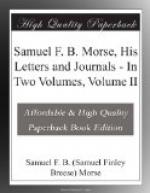Troubles, indeed, came not singly, for, in addition to sorrows of a domestic nature, his friends one by one were taken from him by death, and on November 12, 1869, he writes to William Stickney, Esq., son-in-law of Amos Kendall:—
“Although prepared by recent notices in the papers to expect the sad news, which a telegram this moment received announces to me, of the death of my excellent, long-tried friend Mr. Kendall, I confess that the intelligence has come with a shock which has quite unnerved me. I feel the loss as of a father rather than of a brother in age, for he was one in whom I confided as a father, so sure was I of affectionate and sound advice....
“I need not tell you how deeply I feel this sad bereavement. I am truly and severely bereaved in the loss of such a friend, a friend, indeed, upon whose faithfulness and unswerving integrity I have ever reposed with perfect confidence, a confidence which has never been betrayed, and a friend to whose energy and skill, in the conduct of the agency which I had confided to him, I owe (under God) the comparative comfort which a kind Providence has permitted me to enjoy in my advanced age.”
In the following year he was called upon to mourn the death of still another of his good friends, for, on August 24, 1870, George Wood died very suddenly at Saratoga.
While much of sadness and sorrow clouded the evening of the life of this truly great man, the sun, ere it sank to rest, tinged the clouds with a glory seldom vouchsafed to a mortal, for he was to see a statue erected to him while he was yet living. Of many men it has been said that— “Wanting bread they receive only a stone, and not even that until long after they have been starved to death.” It was Morse’s good fortune not only to see the child of his brain grow to a sturdy manhood, but to be honored during his lifetime to a truly remarkable degree.
The project of a memorial of some sort to the Inventor of the Telegraph was first broached by Robert B. Hoover, manager of the Western Union Telegraph office, Allegheny City, Pennsylvania. The idea once started spread with the rapidity of the electric fluid itself, and, under the able management of James D. Reid, a fund was raised, partly by dollar subscriptions largely made by telegraph operators all over the country, including Canada, and it was decided that the testimonial should take the form of a bronze statue to be erected in Central Park, New York. Byron M. Pickett was chosen as the sculptor, and the Park Commission readily granted permission to place the statue in the park.




